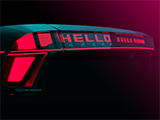- Login
- LOGIN-AREA
- Aftermarket Club
- Deutsch
Technology & Products / 13.12.2021
Digital FlatLight from HELLA enables customizable light signatures and communication
- Innovative FlatLight technology series is continuously being further developed
- Combined with SmartGlass, individually switchable light signatures as well as extended functionality can be realized.
12/13/2021
12/13/2021
With the FlatLight | µMX technology, HELLA already presented an innovative light guide concept using micro-optics at the beginning of 2021. It enables particularly homogeneously illuminated surfaces with an extremely low module depth of only 5 millimetres. At the same time, the technology combines high efficiency with a wide range of design options, as the front surface of the module can be masked with different decors.
Digital FlatLight uses exactly this technology. By using a SmartGlass display, the functionality is increased many times over. In the HELLA VISION | Digital FlatLight prototype presented for the first time at the IAA Mobility 2021, for example, the SmartGlass in front is divided into 44 triangular segments that can be individually switched and dimmed by software. In contrast to a classic display, not only the size and number but also the shape of the individual segments can be individually designed. This eliminates the need for masks and decors. In the case of a series application, vehicle manufacturers are instead given the option of creating different designs, e.g. for each equipment variant, using the HELLA GAIN software.
The Digital FlatLight is based on the FlatLight | µMX optical system. On this basis, it is possible to equip simpler equipment variants with FlatLight and, for example, to expand the functionality of the better equipped variants by adding a SmartGlass display. With the Digital FlatLight, new signatures can be easily programmed for a possible facelift. New business models such as the installation and adaptation of graphics via app or software update are also conceivable in this context. Another plus point: when switched off, the Digital FlatLight impresses with its "Black Panel" look, a homogeneous glossy black surface. Alternatively, the SmartGlass can be used to make the selected signature visible even when it is not illuminated.
"Our Digital FlatLight technology is a big step towards the future. Already today it allows to display fonts and symbols. In addition, light signatures that adapt to the driving modes, text or symbols that warn road users of traffic jams or icy roads, or graphics that display the battery charge level of the electric vehicle can also be realized with this technology," says Dr. Huber. In order to further increase the resolution of the rear combination lamp and thus the range of functions, HELLA is working to further increase the segmentation, i.e. the number of pixels. This is possible, for example, by integrating Active Matrix Displays. This means that the vision of a communicating vehicle is becoming more and more of a reality.
2021
Contact
Daniel Morfeld
Spokesperson / Media Relations
Rixbecker Str. 75
59552 Lippstadt
Phone: +49 2941 38-7566
Fax: +49 2941 38-477545
Daniel.Morfeld@forvia.com
Spokesperson / Media Relations
Rixbecker Str. 75
59552 Lippstadt
Phone: +49 2941 38-7566
Fax: +49 2941 38-477545
Daniel.Morfeld@forvia.com
12/22/2022


